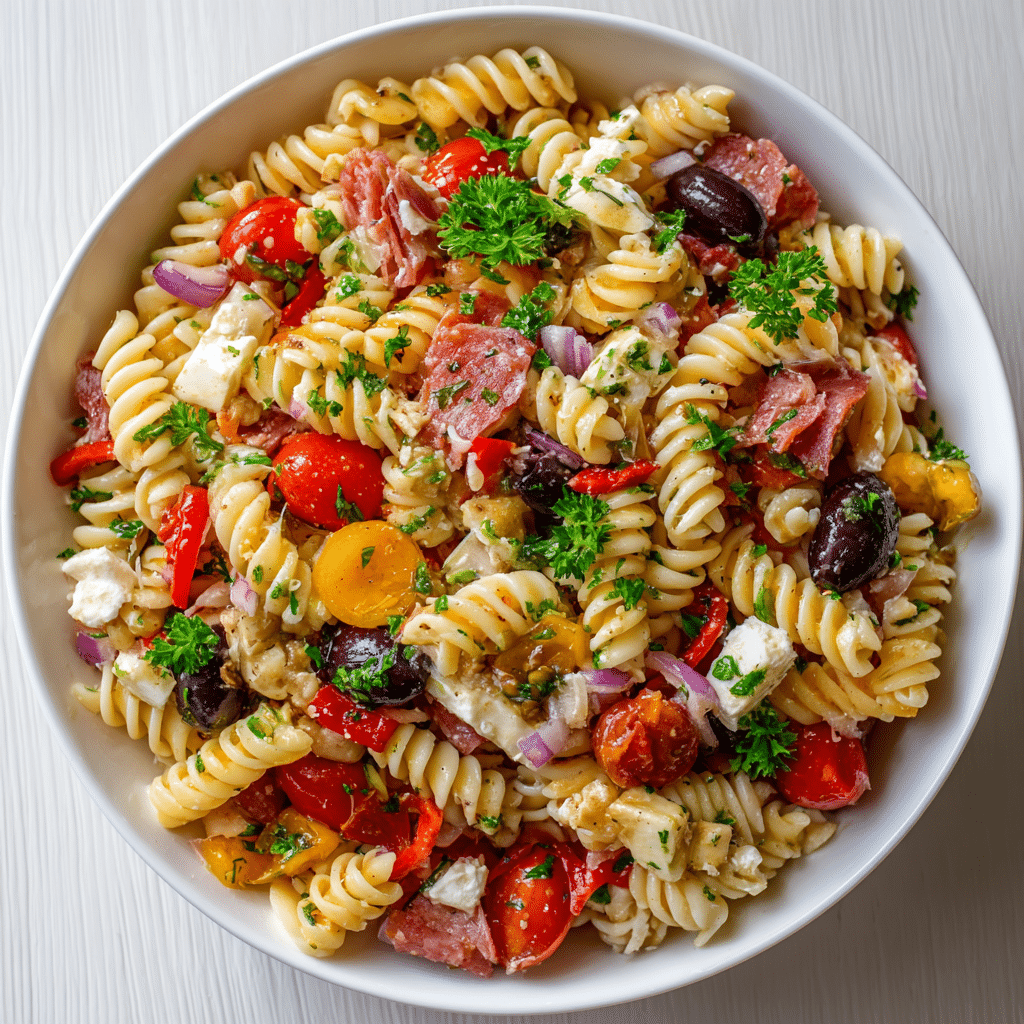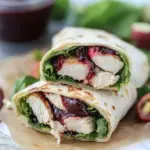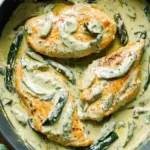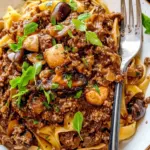This Italian Antipasto Pasta Salad is a celebration of bold Mediterranean flavors and perfect textures. A harmonious blend of rotini pasta, briny olives, crisp veggies, rich cheeses, and savory meats all tossed in a zesty vinaigrette, this dish brings an irresistible contrast of flavors and colors to the table. It’s the kind of recipe that works as both a hearty side and a satisfying main, especially during warm-weather gatherings.
Whether you’re planning a summer picnic, a potluck party, or a quick weeknight dinner, this pasta salad checks every box. It can be made ahead, is served cold, and is endlessly customizable. Swap salami for pepperoni, throw in some chickpeas for extra protein, or keep it vegetarian by omitting the meat. No matter how you build it, this salad delivers the vibrant taste of Italy in every bite.
Full Recipe
Ingredients:
-
12 oz rotini pasta
-
1 cup cherry tomatoes, halved
-
1 cup marinated artichoke hearts, chopped
-
1/2 cup roasted red peppers, sliced
-
1/2 cup black olives, halved
-
1/2 cup green olives, halved
-
1/2 cup pepperoncini, chopped
-
1/3 cup red onion, finely chopped
-
1/2 cup cubed mozzarella
-
1/2 cup sliced salami
-
1/3 cup grated parmesan
-
1/4 cup chopped fresh parsley
-
Salt and pepper to taste
Dressing:
-
1/2 cup olive oil
-
1/4 cup red wine vinegar
-
2 tablespoons Dijon mustard
-
1 tablespoon lemon juice
-
1 garlic clove, minced
-
1 teaspoon dried oregano
-
Salt and pepper to taste
Directions:
-
Cook pasta according to package directions until al dente. Drain and rinse under cold water.
-
In a small bowl or jar, whisk together all the dressing ingredients until emulsified.
-
In a large bowl, combine cooked pasta, tomatoes, artichokes, peppers, olives, pepperoncini, onion, mozzarella, salami, parmesan, and parsley.
-
Pour dressing over the pasta mixture and toss until everything is evenly coated.
-
Season with salt and pepper to taste.
-
Chill in the fridge for at least 30 minutes before serving for best flavor.
Prep Time: 20 minutes | Cooking Time: 10 minutes | Total Time: 30 minutes
Kcal: 420 kcal | Servings: 6 servings
Introduction to Italian Antipasto Pasta Salad
Italian Antipasto Pasta Salad is a vibrant, crowd-pleasing dish that brings together the heartiness of pasta with the robust flavors of traditional antipasto ingredients. Perfect for summer picnics, potlucks, lunch gatherings, or a quick make-ahead dinner, this recipe delivers a balance of tangy, salty, and savory elements in every bite. While pasta salad is commonly thought of as a simple side dish, this version is elevated by the inclusion of antipasto favorites like salami, olives, artichoke hearts, roasted red peppers, and chunks of mozzarella. All of these are tossed with a zingy vinaigrette that soaks into the pasta, enhancing its flavor the longer it sits.
Antipasto, which means “before the meal” in Italian, is traditionally served as a first course featuring cured meats, cheeses, pickled vegetables, and olives. This pasta salad captures all those classic flavors and textures in one refreshing and colorful bowl. It combines the comfort and carb-satisfaction of pasta with the intense and layered taste of antipasto ingredients, making it a true one-bowl wonder that can function as a main dish or a bold accompaniment to grilled meats or seafood.
Origins and Inspiration Behind the Recipe
The inspiration for this Italian Antipasto Pasta Salad lies in the timeless art of Italian antipasto platters. These are known for their variety, flavor, and visual appeal, typically combining a mixture of cured meats, cheese, marinated vegetables, and pickled items. The concept of turning that into a salad not only saves time during entertaining but also allows the ingredients to intermingle in a way that enhances their individual flavors. Every component—from the chewy pasta to the bite of pepperoncini and the creamy pockets of cheese—contributes to a balanced, satisfying bite.
What makes this recipe stand out is its versatility. It’s not bound by strict rules—feel free to personalize it with what you have on hand or prefer. The essential concept is creating a flavor profile that’s tangy, savory, a little spicy, and packed with texture. Its roots may be Italian, but its application is globally appreciated.
The Role of the Vinaigrette
One of the defining features of this antipasto pasta salad is its homemade vinaigrette. Rather than relying on heavy mayonnaise or creamy dressings typical of other pasta salads, this dish shines with a zesty, oil-based dressing made with olive oil, red wine vinegar, Dijon mustard, garlic, oregano, and lemon juice. The acidity cuts through the richness of the cheese and meats while complementing the briny elements like olives and pepperoncini. The vinaigrette is also absorbent-friendly, which means the pasta soaks up the flavor the longer it sits, making it even more delicious over time.
Perfect for Make-Ahead Meals and Gatherings
Another major advantage of this salad is that it tastes better after resting. Unlike green salads, which tend to wilt or get soggy, pasta salad holds up well, and its flavors deepen over time. This makes it ideal for preparing ahead of time—great for meal prep, outdoor parties, or anytime you need to bring a dish that holds up without reheating.
Whether you’re hosting a brunch, organizing a picnic, or planning your weekly lunches, this pasta salad can be made the night before and stored in the fridge. By the next day, every ingredient will be perfectly marinated, and the dressing will have had time to seep into every spiral of the pasta.
Ingredient Pairings and Variations
While the original version includes rotini pasta, mozzarella cubes, salami, olives, red onions, roasted red peppers, and artichoke hearts, you can easily make substitutions to tailor the dish to your taste or dietary needs. For a vegetarian version, skip the salami and add extra vegetables like grilled zucchini, chickpeas, or sun-dried tomatoes. For a lower-carb version, swap the pasta with cooked cauliflower florets or spiralized zucchini.
Cheese lovers may want to go beyond mozzarella and experiment with provolone, mini bocconcini, or even crumbled feta for a Mediterranean twist. If you prefer a spicier kick, try hot capicola or spicy soppressata instead of salami. Adding fresh herbs like basil, parsley, or oregano also enhances freshness and elevates the dish.
Serving Suggestions and Presentation Tips
Presentation matters, especially when serving a dish as colorful and ingredient-rich as this pasta salad. Use a large, shallow bowl to showcase the layers of ingredients, and garnish with extra herbs or shaved parmesan for visual impact. If serving to a large group, consider plating the salad over a bed of arugula or spinach for added greens and structure.
This salad pairs well with grilled dishes such as lemon herb chicken, balsamic-glazed steak, or even simple garlic shrimp. For a vegetarian meal, serve it alongside a crusty loaf of Italian bread and a glass of crisp white wine for a complete Mediterranean experience.
Why This Pasta Salad Works All Year Round
Although often enjoyed in warm months due to its refreshing qualities, this pasta salad is suitable year-round. During the holidays, it can bring a splash of color and brightness to rich winter spreads. Its ingredient list makes it especially practical because it uses pantry staples like pasta, canned or jarred vegetables, and preserved meats. This means you can make it anytime without a special grocery run.
Additionally, the salad is a hit with both adults and children, especially if the spicier elements are toned down. It’s also a great addition to buffets and potlucks because it holds its shape and flavor without needing to be kept warm.
Storage and Leftovers
Leftovers of this salad can be stored in an airtight container in the refrigerator for up to 4 days. In fact, the flavors tend to develop more deeply after a day or two, making the leftovers just as good—if not better—than when it was first made. If the pasta starts to absorb too much dressing and becomes dry, a splash of olive oil and vinegar can bring it back to life.
This recipe also travels well, making it a reliable option for work lunches, school meals, and on-the-go eating. Just be sure to pack it with an ice pack if you’re taking it outdoors or in warm weather.
Health Considerations and Customization
This pasta salad is relatively balanced with protein from cheese and salami, fiber from vegetables, and healthy fats from the vinaigrette. However, those watching their sodium intake might want to limit or substitute some of the saltier ingredients like olives, pepperoncini, and cured meats. Using whole wheat pasta can also boost the fiber content.
Gluten-free versions are easy to make with chickpea or rice-based pasta. You can also experiment with legume-based pasta for extra protein or add beans like cannellini or kidney beans for heartiness.
Conclusion
Italian Antipasto Pasta Salad is more than just a side—it’s a culinary experience that captures the essence of traditional antipasto with the comfort of pasta. It’s colorful, satisfying, and bursting with flavor in every bite. Whether you’re preparing it for a picnic, a casual dinner, or a festive gathering, this dish offers convenience without sacrificing taste or sophistication.
Its adaptability makes it a recipe worth mastering and reinventing with seasonal produce or pantry staples. And because it only gets better as it rests, it’s one of those dishes you can confidently prepare in advance and still impress your guests.
From its vibrant presentation to its medley of textures and bold Italian-inspired flavors, this pasta salad earns its place in any home cook’s rotation. Try it once, and you’ll find yourself returning to it again and again—not only for its ease but also for how it consistently delivers crowd-pleasing results.






